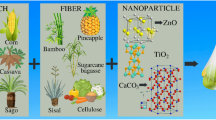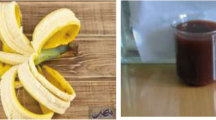Abstract
Recent applications of nanotechnology in agriculture have successfully demonstrated the utility of nanomaterials as a potential plant-growth regulator. Practical application of nanomaterial-based fertilizers in agricultural lands requires a suitable substrate to effectively disperse the nanomaterials. In this study, a polymeric formulation of PVA–starch was synthesized as a substrate for the slow release of the Cu–Zn micronutrient carrying carbon nanofibers (CNFs). The Cu–Zn/CNFs were in situ dispersed in the PVA–starch blend during a polymerization step. The effectiveness of the prepared nanofertilizer was demonstrated using chickpea as a model plant and different doses, viz. 0.25, 0.50, 1.0, 2.0 and 4.0 g of PBMC per kg of soil (garden) up to 30 days. The dissolution of PBMC increased with increasing amounts of starch in the PBMC matrix, indicating the biodegradability of PVA in the blend. Scanning electron microscopy and elemental analysis confirmed the translocation of the Cu–Zn/CNFs from roots to shoots of the plant. The PBMC(1-1)-grown plants were measured to be the tallest (~ 33 cm), whereas the control plants reached a length of ~ 18 cm only, indicating the effectiveness of the prepared micronutrient in sustaining the plant growth. The superoxide anion radicals and hydrogen peroxide in the control plants were measured to be 207 ± 3.15 and 272 ± 5.74 nmol/g of the plant, whereas PBMC(1-1)-grown plants contained 129 ± 3.25 and 194 ± 6.47 nmol/g of the reactive oxygen species, respectively, indicating that the Zn nanoparticles were effective in scavenging the reactive species. The metal release profiles of PBMC indicated the Cu and Zn concentrations to be 5.3 ± 0.05 and 2.8 ± 0.1 mg/g-CNF, respectively, which were significantly lower from Cu–Zn/CNF, attributed to the slow release of the metals from the prepared polymeric formulation. The proposed integration of the biodegradable polymeric formulation with the micronutrient carrying CNFs opens a new perspective on the application of nanotechnology in agricultural practices.








Similar content being viewed by others
References
Alexander G, Katja K, Thomas DB (2012) Nanomaterials in plant protection and fertilization: current state, foreseen applications, and research priorities. J Agric Food Chem 60:9781–9792
Zheng L, Hong F, Lu S, Liu C (2005) Effect of nano-TiO2 on spinach of naturally aged seeds and growth of spinach. Biol Trace Element Res 104:83–91
Klaine SJ, Alvarez PJJ, Batley GE, Fernandes TF, Handry RD, Lyon DY, Manendra S, McKaughlin MJ, Lead JR (2008) Nanomaterials in the environment: behavior, fate bioavailability, and effects. Environ Toxicol Chem 27:1825–1851
Laware S, Raskar S (2014) Influence of zinc oxide nanoparticles on growth, flowering and seed productivity in onion. Int J Curr Microbiol Appl Sci 3:874–881
Hafeez A, Razzaq A, Mahmood T, Jhanzab HM (2015) Potential of copper nanoparticles to increase growth and yield of wheat. J Nanosci Adv Technol 1:6–11
Mondal A, Basu R, Das S, Nandyet P (2011) Beneficial role of carbon nanotubes on mustard plant growth: an agricultural prospect. J Nanopart Res 13:4519–4528
Khodakovskaya MV, De-Silva K, Nedosekin D, Dervishi E, Biris AS, Shashkov EV, Galanzha EI, Zharov VP (2011) Complex genetic, photothermal, and photoacoustic analysis of nanoparticle-plant interactions. Proc Natl Acad Sci USA 108:1028–1033
Khodakovskaya MV, Kim BS, Kim JN, Alimohammadi M, Dervishi E, Mustafa T, Cernigla CE (2013) Carbon nanotubes as plant growth regulators: effects on tomato growth, reproductive system, and soil microbial community. Small 9:115–123
Khodakovskaya MV, De-Silva K, Biris AS, Dervishi E, Villagarcia H (2012) Carbon nanotubes induce growth enhancement of tobacco cells. ACS Nano 3:2128–2135
Ashfaq M, Verma N, Khan S (2017) Carbon nanofibers as a micronutrient carrier in plants: efficient translocation and controlled release of Cu nanoparticles. Environ Sci Nano 4:138–148
Torney F, Trewyn BG, Lin VSY, Wang K (2007) Mesoporous silica nanoparticles deliver DNA and chemicals into plants. Nature Nano 2:295–300
Liu Q, Chen B, Wang Q, Shi X, Xiao Z, Lin J, Fang X (2009) Carbon nanotubes as molecular transporters for walled plant cells. Nano Lett 9:1007–1010
Davern SM, McKnight TE, Standaert RF, Morrell-Falvey JL, Shpak ED, Kalluri UC, Jelenska J, Greenberg JT, Mirzadeh S (2016) Carbon nanofiber arrays: a novel tool for microdelivery of biomolecules to plants. PLoS ONE 11:e0153621
De La Torre-Roche R, Hawthorne J, Deng Y, Xing B, Cai W, Newman LA, Wang Q, Ma X, Hamdi H, White JC (2013) Multiwalled carbon nanotubes and C60 fullerenes differentially impact the accumulation of weathered pesticides in four agricultural plants. Environ Sci Technol 47:12539–12547
Song U, Jun H, Waldman B, Roh J, Kim Y, Yi J, Lee EJ (2013) Functional analyses of nanoparticle toxicity: a comparative study of the effects of TiO2 and Ag on tomatoes (Lycopersicon esculentum). Ecotoxicol Environ Saf 93:60–67
Sabo-Attwood T, Unrine JM, Stone JW, Murphy CJ, Ghoshroy S, Blom D, Bertsch PM, Newman LA (2012) Uptake, distribution and toxicity of gold nanoparticles in tobacco (Nicotiana xanthi) seedlings. Nanotoxicology. 6:353–360
Tomaszewska M, Jarosiewicz A (2002) Use of polysulfone in controlled-release NPK fertilizer formulations. J Agric Food Chem 50:4634–4639
Jarosiewicz A, Tomaszewska M (2003) Controlled-release NPK fertilizer encapsulated by polymeric membranes. J Agric Food Chem 51:413–417
Wu L, Liu M (2008) Preparation and properties of chitosan-coated NPK compound fertilizer with controlled-release and water-retention. Carbohydr Polym 72:240–247
De-Campos Bernardi AC, Oliviera PP, De-Melo Monte MB, Souza-Barros F (2013) Brazilian sedimentary zeolite use in agriculture. Micropor Mesopor Mater 167:16–21
Anstoetz M, Sharma N, Clark M, Yee LH (2016) Characterization of an oxalate-phosphate-amine metal-organic framework (OPA-MOF) exhibiting properties suited for innovative applications in agriculture. J Mater Sci 51:9239–9252. https://doi.org/10.1007/s10853-016-0171-6
Ray SK, Varadachari C, Ghosh K (1997) Novel slow-releasing micronutrient fertilizers. 2. Copper compounds. J Agric Food Chem. 45:1447–1453
Chandra PK, Ghosh K, Varadachari C (2009) A new slow-releasing iron fertilizer. Chem Eng J 155:451–456
Bin Hussein MZ, Zainal Z, Yahaya AH, Foo DW (2002) Controlled release of a plant growth regulator, α-naphthaleneacetate from the lamella of Zn–Al-layered double hydroxide nanocomposite. J Control Release 82:417–427
Quiñones JP, García YC, Curiel H, Covas CP (2010) Microspheres of chitosan for controlled delivery of brassinosteroids with biological activity as agrochemicals. Carbohydr Polym 80:915–921
Malinconico M, Immirzi B (2002) Blends of polyvinylalcohol and functionalized polycaprolactone. A study on the melt extrusion and post-cure of films suitable for protected cultivation. J Mater Sci 37:4973–4978. https://doi.org/10.1023/A:1021058810774
Tang X, Alavi S (2011) Recent advances in starch, polyvinyl alcohol based polymer blends, nanocomposites and their biodegradability. Carbohydr Polym 85:7–16
Marschner H (1995) Mineral nutrition of higher plants, 2nd edn. Academic Press, London
Singh A, Singh NB, Afzal S, Singh T, Hussain I (2018) Zinc oxide nanoparticles: a review of their biological synthesis, antimicrobial activity, uptake, translocation and biotransformation in plants. J Mater Sci 53:185–201. https://doi.org/10.1007/s10853-017-1544-1
Ashfaq M, Singh S, Sharma A, Verma N (2013) Cytotoxic evaluation of the hierarchical web of carbon micronanofibers. Ind Eng Chem Res 52:4672–4682
Ashfaq M, Verma N, Khan S (2016) Copper/zinc bimetal nanoparticles-dispersed carbon nanofibers: a novel potential antibiotic material. Mater Sci Eng C 59:938–947
Ashfaq M, Khan S, Verma N (2014) Synthesis of PVA-CAP-based biomaterial in situ dispersed with Cu nanoparticles and carbon micro-nanofibers for antibiotic drug delivery applications. Biochem Eng J 90:79–89
Ashfaq M, Verma N, Khan S (2017) Highly effective Cu/Zn-carbon micro/nanofiber-polymer nanocomposite-based wound dressing biomaterial against the P. aeruginosa multi- and extensively drug-resistant strains. Mater Sci Eng C 77:630–641
Yew SP, Tang HY, Sudesh K (2006) Photocatalytic activity and biodegradation of polyhydroxybutyrate films containing titanium dioxide. Polym Degrad Stab 91:1800–1807
Ni Z, Kim E, Ha M, Lackey E, Liu J, Zhang Y, Sun Q, Chen ZJ (2009) Altered circadian rhythms regulate growth vigour in hybrids and allopolyploids. Nature 457:327–333
Lopez CVG, García MDCC, Fernández AGA, Bustos CS, Chisti Y, Sevilla JMF (2010) Protein measurements of microalgal and cyanobacterial biomass. Bioresour Technol 101:7587–7591
Elstner EF, Heupel A (1976) Inhibition of nitrite formation from hydroxylammoniumchloride: a simple assay for superoxide dismutase. Anal Biochem 70:616–620
Velikova V, Yordanov I, Edreva A (2000) Oxidative stress and some antioxidant systems in acid rain-treated bean plants: protective role of exogenous polyamines. Plant Sci 151:59–66
Lin S, Reppert J, Hu Q, Hudson JS, Reid ML, Ratnikova TA, Rao AM, Luo H, Ke PC (2009) Uptake, translocation, and transmission of carbon nanomaterials in rice plants. Small 5:1128–1132
Chichiriccò G, Poma A (2015) Penetration and toxicity of nanomaterials in higher plants. Nanomaterials 5:851–873
Samreen T, Shah HU, Ullah S, Javid M (2013) Zinc effect on growth rate, chlorophyll, protein and mineral contents of hydroponically grown mungbeans plant (Vigna radiate L.). Arab J Chem 10:S1802–S1807
Amaya I, Botella MA, de la Calle M, Medina MI, Heredia A, Bressan RA, Hasegawa PM, Quesada MA, Valpuesta V (1999) Improved germination under osmotic stress of tobacco plants overexpressing a cell wall peroxidase. FEBS Lett 457:80–84
Turner AP (1994) The responses of plants to heavy metals. In: Ross SM (ed) Toxic metals in soil-plant systems. Wiley, Chichester, pp 153–187
Foyer CH, Harbinson J (1994) Oxygen metabolism and the regulation of photosynthetic electron transport. In: Foyer CH, Mullineaux P (eds) Causes of photooxidative stresses and amelioration of defense systems in plants. CRC Press, Boca Raton, pp 1–42
Del Rio LA, Sandalio LM, Corpas FJ, Palma JM, Barroso JB (2006) Reactive oxygen species and reactive nitrogen species in peroxisomes: production, scavenging, and role in cell signaling. Plant Physiol 141:330–335
Begum P, Fugetsu B (2012) Phytotoxicity of multi-walled carbon nanotubes on red spinach (Amaranthus tricolor L.) and the role of ascorbic acid as an antioxidant. J Hazard Mater 243:212–222
Da-Costa MVJ, Sharma PK (2016) Effect of copper oxide nanoparticles on growth, morphology, photosynthesis, and antioxidant response in Oryza sativa. Photosynthetica 54:110–119
Kumari M, Khan SS, Pakrashi S, Mukherjee A, Chandrasekaran N (2011) Cytogenetic and genotoxic effects of zinc oxide nanoparticles on root cells of Allium cepa. J Hazard Mater 190:613–621
Acknowledgements
The authors acknowledge the financial support received from the Council of Scientific & Industrial Research (CSIR) (New Delhi, India) in the form of a research grant (No: 9 22(4803)/14). The authors also acknowledge the provision of ACFs from Kynol Inc. (Tokyo, Japan).
Author information
Authors and Affiliations
Corresponding author
Electronic supplementary material
Below is the link to the electronic supplementary material.
Rights and permissions
About this article
Cite this article
Kumar, R., Ashfaq, M. & Verma, N. Synthesis of novel PVA–starch formulation-supported Cu–Zn nanoparticle carrying carbon nanofibers as a nanofertilizer: controlled release of micronutrients. J Mater Sci 53, 7150–7164 (2018). https://doi.org/10.1007/s10853-018-2107-9
Received:
Accepted:
Published:
Issue Date:
DOI: https://doi.org/10.1007/s10853-018-2107-9




